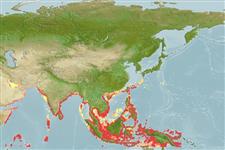>
Clupeiformes (Herrings) >
Dorosomatidae (Gizzard shads and sardinellas)
Etymology: Sardinella: Latin and Greek, sarda = sardine; name related to the island of Sardinia; diminutive (Ref. 45335).
More on author: Valenciennes.
Environment: milieu / climate zone / depth range / distribution range
Ecologia
marinhas; estuarina; intervalo de profundidade 0 - 50 m (Ref. 188). Tropical; 30°N - 11°S, 47°E - 153°E (Ref. 188)
Indo-West Pacific: from Kuwait to southern India and Bay of Bengal to the Philippines, also eastern tip of Papua New Guinea. Often confused with Sardinella gibbosa in Indian waters.
Length at first maturity / Tamanho / Peso / Idade
Maturity: Lm 12.3, range 10 - ? cm
Max length : 19.0 cm TL macho/indeterminado; (Ref. 2178); common length : 11.0 cm SL macho/indeterminado; (Ref. 188)
Espinhos dorsais (total): 0; Raios dorsais moles (total): 18-19; Espinhos anais 0; Raios anais moles: 18 - 20. This species is distinguished by the following characters: deep body, its depth 28·0-33·2% SL; interrupted longitudinal striae formation in lateral scales; scutes prepelvic and post-pelvic 17-18 + 11-12, respectively, oftern 18 + 12; A 18-20 rays, usually 19; lower gill rakers 65-81 (Ref. 114969).
Forms schools in coastal waters. Misidentifications (especially with S. gibbosa in Indian waters and S. albella in the western Indian Ocean) make published biological data potentially unreliable. Marketed fresh, dried-salted, boiled or made into fish balls.
Whitehead, P.J.P., 1985. FAO Species Catalogue. Vol. 7. Clupeoid fishes of the world (suborder Clupeoidei). An annotated and illustrated catalogue of the herrings, sardines, pilchards, sprats, shads, anchovies and wolf-herrings. FAO Fish. Synop. 125(7/1):1-303. Rome: FAO. (Ref. 188)
Categoria na Lista Vermelha da IUCN (Ref. 130435)
Ameaça para o homem
Harmless
Utilização humana
Pescarias: espécies comerciais
Mais informação
ColaboradoresFotografiasStamps, Coins Misc.SonsCiguateraVelocidadeTipo de nataçãoÁrea branquialOutras referênciasCérebrosVisão
Ferramentas
Relatórios especiais
Descarregue XML
Fontes da internet
Estimates based on models
Preferred temperature (Ref.
123201): 27.5 - 29.2, mean 28.6 °C (based on 862 cells).
Phylogenetic diversity index (Ref.
82804): PD
50 = 0.5000 [Uniqueness, from 0.5 = low to 2.0 = high].
Bayesian length-weight: a=0.00813 (0.00515 - 0.01282), b=2.98 (2.85 - 3.11), in cm total length, based on LWR estimates for this species & Genus-body shape (Ref.
93245).
Nível Trófico (Ref.
69278): 2.7 ±0.30 se; based on food items.
Generation time: 1.2 (0.7 - 1.6) years. Estimated as median ln(3)/K based on 10
growth studies.
Resiliência (Ref.
120179): Elevada, tempo mínimo de duplicação da população menor que 15 meses (K=0.7-1.6; tmax=3).
Prior r = 0.84, 95% CL = 0.56 - 1.26, Based on 1 stock assessment.
Fishing Vulnerability (Ref.
59153): Low vulnerability (10 of 100).
Climate Vulnerability (Ref.
125649): Moderate to high vulnerability (53 of 100).
Nutrients (Ref.
124155): Calcium = 426 [251, 679] mg/100g; Iron = 2.7 [1.7, 4.3] mg/100g; Protein = 20.6 [19.7, 21.5] %; Omega3 = 0.318 [0.165, 0.607] g/100g; Selenium = 106 [55, 204] μg/100g; VitaminA = 19.9 [8.0, 50.8] μg/100g; Zinc = 2.01 [1.49, 2.67] mg/100g (wet weight); based on
nutrient studies.
